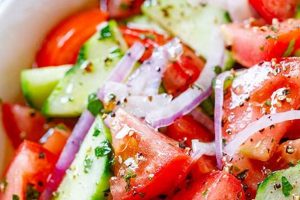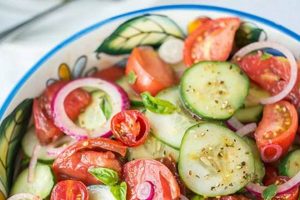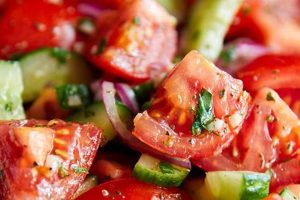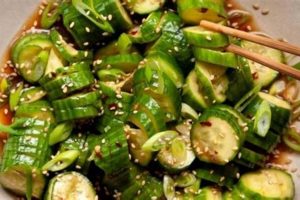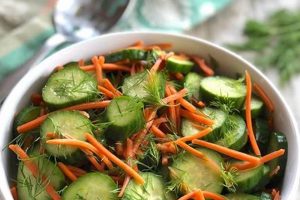This simple dish combines the refreshing crispness of cucumbers, the juicy sweetness of tomatoes, and the pungent bite of onions. A basic version typically involves slicing these vegetables and tossing them with a vinaigrette. Variations can include other ingredients such as herbs, feta cheese, olives, or different types of vinegar and oil.
A salad composed of these core ingredients offers a hydrating and nutritious side dish or light meal. Rich in vitamins, minerals, and antioxidants, it provides a flavorful way to incorporate more vegetables into one’s diet. Such salads have likely been enjoyed for centuries, adapting to regional produce and culinary traditions worldwide. The accessibility of the ingredients makes it a popular choice across various cultures.
The following sections will delve into specific recipe variations, offer tips for selecting the best produce, and explore different techniques for preparing this versatile and healthful salad.
Tips for a Perfect Cucumber, Tomato, and Onion Salad
Elevating this simple salad involves attention to detail and a focus on freshness. The following tips offer guidance on ingredient selection and preparation techniques.
Tip 1: Choose ripe, flavorful tomatoes. Locally sourced, in-season tomatoes offer superior flavor. Look for vibrant color and a slight give when gently squeezed.
Tip 2: Opt for firm, unwaxed cucumbers. English cucumbers are ideal due to their thin skin and minimal seeds. If using standard cucumbers, consider peeling them partially to reduce bitterness.
Tip 3: Select the right onion. Red onions provide a sharp, peppery flavor and vibrant color. Sweet onions, such as Vidalia or Walla Walla, offer a milder taste. Shallots can add a delicate, nuanced flavor.
Tip 4: Salt the vegetables. Salting the cucumbers and onions before combining them with the other ingredients draws out excess moisture, preventing a watery salad. Allow them to sit for about 10 minutes, then pat dry.
Tip 5: Balance flavors with the vinaigrette. A simple vinaigrette of olive oil, vinegar, salt, and pepper works well. Experiment with different types of vinegar, such as red wine vinegar, white wine vinegar, or apple cider vinegar.
Tip 6: Add fresh herbs. Fresh herbs like dill, parsley, mint, or oregano can significantly enhance the flavor profile.
Tip 7: Chill before serving (optional). Chilling allows the flavors to meld and enhances the refreshing qualities of the salad. However, some prefer the salad at room temperature to better appreciate the individual flavors.
By following these suggestions, one can create a vibrant and flavorful salad that highlights the natural qualities of the ingredients.
The concluding section offers variations and serving suggestions for incorporating this versatile salad into a variety of meals.
1. Fresh, High-Quality Ingredients
The success of a cucumber, tomato, and onion salad hinges directly on the quality of its ingredients. Freshness not only impacts flavor but also texture and overall appeal. Using high-quality produce elevates this simple dish from ordinary to extraordinary.
- Ripe Tomatoes:
Tomatoes form the heart of this salad. Ripe, flavorful tomatoes, preferably locally sourced and in-season, contribute sweetness and juiciness. Out-of-season or underripe tomatoes can be bland and watery, diminishing the salad’s vibrancy. Heirloom varieties offer a range of flavors and colors, enhancing both taste and visual appeal. Look for tomatoes with vibrant skin, a pleasant aroma, and a slight give when gently pressed.
- Crisp Cucumbers:
Cucumbers provide a refreshing counterpoint to the tomatoes. Firm, unwaxed cucumbers, such as English or Persian varieties, offer optimal texture and minimize bitterness. If using standard cucumbers, consider peeling them partially to reduce any potential bitterness from the skin. Look for cucumbers that are firm to the touch and free from blemishes.
- Pungent Onions:
Onions add a sharp, savory note. The choice of onion variety influences the salad’s overall flavor profile. Red onions provide a pungent bite and vibrant color, while sweeter varieties like Vidalia or Walla Walla offer a milder taste. Shallots provide a delicate, nuanced flavor. Consider soaking sliced red onions in cold water to mellow their sharpness if desired.
- Aromatic Herbs:
Fresh herbs elevate the salad’s flavor profile. Dill, parsley, mint, and oregano are popular choices, each contributing a unique aroma and taste. Using freshly chopped herbs maximizes their flavor impact. Experiment with different combinations to find a preferred blend. The quality and freshness of the herbs are paramount; wilted or dried herbs will not provide the same vibrant flavor.
By prioritizing fresh, high-quality ingredients, one ensures a vibrant and flavorful cucumber, tomato, and onion salad. The synergy of these carefully chosen components creates a dish that is greater than the sum of its parts, showcasing the natural flavors of each element.
2. Proper Slicing Techniques
Proper slicing techniques are integral to a successful cucumber, tomato, and onion salad. Uniformly sliced vegetables ensure even distribution of flavor, contribute to a visually appealing presentation, and affect the overall texture of the salad. Inconsistently sized pieces can lead to an unbalanced eating experience, with some bites dominated by one ingredient and others lacking key components. Thinly and evenly sliced onions, for instance, distribute their pungent flavor throughout the salad, while thickly cut pieces can overpower a single bite. Similarly, uniformly sliced cucumbers and tomatoes provide a consistent textural experience.
Consider the difference between a salad with thinly sliced cucumbers and one with thickly cut chunks. The thin slices offer a delicate crunch and integrate seamlessly with the other ingredients, while the thick chunks can feel unwieldy and disrupt the balance of textures. This principle applies to all components of the salad. Precise slicing also allows the vinaigrette to coat the vegetables evenly, maximizing flavor distribution. Furthermore, uniform slices contribute to a more aesthetically pleasing presentation, enhancing the dining experience.
Mastery of basic knife skills, such as the proper grip and use of a sharp knife, ensures consistent slicing. Specific techniques, like the use of a mandoline for achieving paper-thin cucumber slices or a sharp chef’s knife for dicing tomatoes, can further enhance the salad’s overall quality. Attention to these details elevates the final product from a simple mix of ingredients to a carefully constructed dish that showcases both culinary skill and appreciation for the ingredients themselves. Ultimately, the application of proper slicing techniques reflects a commitment to achieving a balanced and harmonious culinary experience.
3. Balanced Vinaigrette
A balanced vinaigrette is crucial for a successful cucumber, tomato, and onion salad. The vinaigrette acts as a unifying element, binding the individual ingredients and creating a cohesive flavor profile. It provides acidity to cut through the richness of the vegetables, sweetness to complement their natural sugars, and an element of fat to carry flavor and create a pleasing mouthfeel. A vinaigrette that is too acidic can overpower the delicate flavors of the vegetables, while one that lacks acidity can result in a bland and uninspiring salad. Similarly, an overly sweet or excessively oily dressing can mask the natural flavors of the fresh produce.
The classic vinaigrette, comprised of oil, vinegar, salt, and pepper, offers a versatile foundation. The ratio of oil to vinegar typically ranges from 2:1 to 3:1, with the specific ratio influencing the intensity of the vinaigrette. Extra virgin olive oil contributes a fruity and peppery flavor, while other oils, such as avocado or grapeseed oil, offer more neutral profiles. Different types of vinegar, such as red wine vinegar, white wine vinegar, balsamic vinegar, or apple cider vinegar, each impart distinct flavor characteristics. Red wine vinegar provides a robust and tangy note, while white wine vinegar offers a brighter, more acidic flavor. Balsamic vinegar introduces a complex sweetness, and apple cider vinegar adds a subtle fruitiness. The choice of vinegar depends on the desired flavor profile of the salad and personal preference.
Beyond the basic ingredients, additional elements can enhance the vinaigrette. Fresh herbs, such as dill, mint, parsley, or oregano, contribute aromatic complexity. Minced garlic or shallots add pungent notes. A touch of Dijon mustard can act as an emulsifier, helping to bind the oil and vinegar together. Honey or maple syrup can add a touch of sweetness to balance the acidity. The key is to achieve a harmonious balance of flavors that complements the fresh vegetables without overpowering them. A well-executed vinaigrette elevates the cucumber, tomato, and onion salad from a simple side dish to a complex and satisfying culinary experience.
4. Optimal Seasoning
Optimal seasoning is paramount in a cucumber, tomato, and onion salad recipe. It elevates the inherent flavors of the fresh ingredients, creating a balanced and harmonious taste profile. Improper seasoning can result in a bland or overly salty dish, masking the natural sweetness of the tomatoes, the refreshing crispness of the cucumbers, and the pungent bite of the onions. Achieving optimal seasoning requires careful consideration of the individual components and their interaction within the salad.
- Salt:
Salt is the foundation of seasoning, enhancing the natural flavors of the ingredients and drawing out their moisture content. In this salad, salt not only seasons the vegetables directly but also plays a critical role in extracting excess moisture from the cucumbers and onions. This process, often referred to as “sweating” or “salting,” prevents the salad from becoming watery and improves the texture of the vegetables. The type of salt used can influence the final flavor; kosher salt is often preferred for its larger crystals and ease of distribution. Over-salting, however, can easily overpower the delicate flavors of the vegetables.
- Black Pepper:
Black pepper adds a subtle heat and complexity to the salad. Freshly ground black pepper offers a more pronounced and aromatic flavor compared to pre-ground pepper. The amount of black pepper used should complement the other seasonings and the overall flavor profile of the salad, providing a subtle warmth without overwhelming the other flavors. The coarseness of the grind can also affect the intensity of the pepper’s flavor.
- Acidity:
The acidity of the vinaigrette plays a crucial role in seasoning the salad. The vinegar in the vinaigrette not only adds a tangy flavor but also helps to balance the sweetness of the tomatoes and the sharpness of the onions. The type of vinegar used influences the overall flavor profile. For example, red wine vinegar offers a robust tang, while white wine vinegar provides a brighter acidity. Lemon juice can also be used to add a citrusy note. The balance of acidity is critical; too much can make the salad overly tart, while too little can result in a bland dish.
- Herbs and Spices:
Fresh herbs and spices can further enhance the flavor profile of the salad. Dill, mint, parsley, and oregano are common additions, each contributing a unique aroma and flavor. A pinch of red pepper flakes can add a touch of heat. The choice of herbs and spices should complement the other ingredients and the overall flavor profile desired. Fresh herbs are generally preferred over dried herbs for their more vibrant flavor and aroma. However, the quality of dried herbs can vary significantly, and high-quality dried herbs can be a suitable alternative when fresh herbs are unavailable.
The interplay of these seasoning elements is essential for a well-balanced and flavorful cucumber, tomato, and onion salad. The proper balance of salt, pepper, acidity, and herbs enhances the natural flavors of the fresh ingredients, creating a refreshing and satisfying dish. A thoughtful approach to seasoning transforms a simple combination of vegetables into a culinary experience that highlights the nuanced flavors of each component.
5. Appropriate Chilling Time
Appropriate chilling time significantly influences the final quality of a cucumber, tomato, and onion salad. Chilling affects the texture, flavor, and overall palatability of the dish. While some prefer the salad served immediately at room temperature to appreciate the full impact of each ingredient’s flavor, chilling offers distinct advantages. Lower temperatures enhance the crispness of the cucumbers and onions, creating a more refreshing textural experience. Furthermore, chilling allows the flavors of the vinaigrette and the vegetables to meld, resulting in a more cohesive and complex flavor profile. The length of chilling time requires careful consideration; excessive chilling can diminish the flavor of the tomatoes and render them mealy. A typical chilling time of 30 minutes to an hour allows the flavors to meld without compromising the texture or taste of the ingredients. For example, a salad chilled for an hour will offer a more harmonious blend of flavors compared to a salad served immediately after preparation. However, chilling overnight might diminish the vibrant flavors and textures of the ingredients, especially the tomatoes.
The chemical and physical changes that occur during chilling contribute to these effects. Lower temperatures slow down enzymatic activity within the vegetables, preserving their texture and preventing them from becoming mushy. Simultaneously, the chilling process allows the flavors from the vinaigrette to penetrate the vegetables more effectively, enhancing their overall taste. Over-chilling, however, can damage cell walls, leading to a loss of texture and flavor. The optimal chilling time depends on various factors, including the specific ingredients used, the ambient temperature, and personal preference. A salad made with delicate herbs, for example, might benefit from a shorter chilling time to preserve their fresh flavors, while a more robust salad with heartier vegetables can withstand a longer chilling period.
Understanding the impact of chilling time allows for greater control over the final product. Careful consideration of chilling time ensures a cucumber, tomato, and onion salad that balances flavor, texture, and temperature for optimal enjoyment. The appropriate chilling time enhances the refreshing qualities of the salad, making it a perfect accompaniment to a variety of meals. Balancing these factors allows one to create a salad that is both refreshing and flavorful, maximizing the potential of this simple yet versatile dish.
6. Creative Variations
Creative variations transform the basic cucumber, tomato, and onion salad into a versatile dish adaptable to diverse palates and culinary traditions. While the core ingredients provide a refreshing foundation, variations introduce complexity and depth, expanding the salad’s potential beyond a simple side dish. These variations stem from ingredient additions, flavor profile adjustments, and cultural influences. The interplay of these elements creates a spectrum of possibilities, ranging from subtle nuances to bold departures from the traditional recipe. For example, incorporating crumbled feta cheese and Kalamata olives transforms the salad into a classic Greek salad, while the addition of mint, parsley, and sumac creates a vibrant Middle Eastern variation. These additions not only introduce new flavors and textures but also reflect the culinary traditions of different regions.
The impact of creative variations extends beyond mere flavor enhancement. Such variations cater to dietary restrictions and preferences, offering inclusive options for diverse individuals. Substituting the traditional vinaigrette with a lemon-herb dressing creates a lighter, vegan-friendly option. Adding grilled chicken or chickpeas increases the protein content, transforming the salad into a more substantial meal. These adaptable qualities make the cucumber, tomato, and onion salad a versatile component of a balanced diet, suitable for various meal occasions, from light lunches to side dishes at larger gatherings. Furthermore, creative variations encourage culinary exploration and experimentation, allowing individuals to personalize the recipe and discover new flavor combinations. The adaptability of the salad provides a canvas for culinary creativity, fostering an appreciation for fresh ingredients and diverse flavor profiles.
In conclusion, creative variations are essential for maximizing the culinary potential of the cucumber, tomato, and onion salad. These variations not only enhance flavor and texture but also expand the salad’s versatility, making it a suitable dish for various dietary needs and cultural contexts. By understanding the impact of creative variations, one can transform a simple salad into a diverse and satisfying culinary experience, celebrating the adaptability of fresh ingredients and the power of culinary innovation.
7. Flavorful Herb Additions
Flavorful herb additions play a crucial role in elevating the sensory experience of a cucumber, tomato, and onion salad. Herbs introduce aromatic complexity and depth, transforming a simple combination of vegetables into a vibrant and nuanced culinary creation. The selection and application of herbs significantly impact the final flavor profile, offering opportunities for customization and creative expression. Understanding the characteristics of various herbs and their interplay with the core ingredients allows for a more informed and deliberate approach to herb integration.
- Aromatic Enhancement:
Fresh herbs contribute a wide range of aromatic compounds that complement and enhance the natural flavors of cucumbers, tomatoes, and onions. The volatile oils within herbs release distinctive aromas when chopped or bruised, adding layers of complexity to the salad. For instance, dill imparts a bright, slightly tangy aroma, while mint offers a cool, refreshing fragrance. The selection of herbs should consider the desired flavor profile and the interplay of aromas within the salad.
- Flavor Balancing:
Herbs not only add their own distinct flavors but also help balance the existing flavors within the salad. The peppery notes of oregano, for example, can complement the sweetness of ripe tomatoes, while the subtle anise flavor of tarragon can balance the sharpness of red onions. Careful herb selection can create a harmonious balance of flavors, preventing any single ingredient from dominating the overall taste profile. The quantity of herbs used also plays a crucial role in achieving optimal flavor balance.
- Visual Appeal:
In addition to their aromatic and flavor contributions, herbs enhance the visual appeal of the salad. The vibrant green hues of parsley, dill, and mint create a visually appealing contrast against the colors of the vegetables. The varying textures of different herbs, from the delicate fronds of dill to the broader leaves of basil, add visual interest and dimension. Careful arrangement of herbs can elevate the salad’s presentation, transforming it into a more visually engaging dish.
- Cultural Influences:
The use of specific herbs in cucumber, tomato, and onion salads often reflects cultural influences and regional culinary traditions. In Mediterranean cuisine, oregano, mint, and parsley are common additions, reflecting the region’s abundant access to these herbs. Middle Eastern variations might incorporate cilantro and mint, while Eastern European recipes might feature dill and chives. Understanding these cultural influences provides insights into traditional flavor pairings and expands the potential for creative variations.
The strategic incorporation of flavorful herbs elevates the cucumber, tomato, and onion salad from a simple side dish to a complex and nuanced culinary creation. By understanding the multifaceted contributions of herbs, one can create a salad that delights the senses and showcases the harmonious interplay of fresh ingredients. The choice of herbs, their quantity, and their combination with the other ingredients reflect a deliberate approach to flavor building, enhancing the overall dining experience.
Frequently Asked Questions
This section addresses common inquiries regarding the preparation and enjoyment of cucumber, tomato, and onion salads.
Question 1: How can excess moisture be prevented in the salad?
Salting the cucumbers and onions prior to combining them with other ingredients draws out excess water. After slicing, sprinkle the cucumbers and onions with salt and let them sit for 10-15 minutes. Pat them dry with a paper towel before adding them to the salad.
Question 2: What are the best tomato varieties to use?
Ripe, in-season tomatoes offer the best flavor. Heirloom varieties provide diverse flavors and colors. Locally sourced tomatoes are often preferable due to freshness. Avoid overripe or underripe tomatoes, as they can negatively impact the salad’s quality.
Question 3: Can the type of onion be varied?
Red onions contribute a pungent flavor and vibrant color. Sweet onions, such as Vidalia or Walla Walla, provide a milder taste. Shallots offer a delicate, nuanced flavor. The choice depends on individual preference and the desired flavor profile.
Question 4: What is the optimal vinaigrette composition?
A standard vinaigrette consists of a 2:1 or 3:1 ratio of oil to vinegar, seasoned with salt and pepper. Extra virgin olive oil provides a robust flavor, while other oils offer neutral profiles. Experiment with different vinegars, like red wine, white wine, or apple cider, to achieve desired flavor nuances.
Question 5: How long should the salad be chilled?
Chilling enhances the crispness of the vegetables and allows flavors to meld. 30 minutes to an hour in the refrigerator is generally sufficient. Over-chilling can negatively affect the texture and flavor of the tomatoes. Some prefer to serve the salad at room temperature to preserve the full impact of the fresh ingredients.
Question 6: What are some ways to add protein to the salad?
Grilled chicken, chickpeas, or crumbled feta cheese are excellent protein additions. These additions transform the salad into a more substantial meal. Other options include boiled eggs, white beans, or nuts and seeds.
Careful consideration of these points ensures optimal flavor, texture, and enjoyment. Prioritizing fresh ingredients and proper techniques elevates this simple salad into a refreshing and flavorful dish.
This concludes the frequently asked questions section. The next section will offer concluding remarks.
Cucumber Tomato Onion Salad Recipe
This exploration of the cucumber, tomato, and onion salad recipe has highlighted the essential elements that contribute to its success. From the selection of fresh, high-quality ingredients to the proper slicing techniques, balanced vinaigrette, optimal seasoning, appropriate chilling time, creative variations, and flavorful herb additions, each aspect plays a crucial role in the final culinary outcome. The emphasis on freshness, proper technique, and balanced flavors underscores the potential of this seemingly simple salad to become a truly satisfying culinary experience.
The cucumber, tomato, and onion salad recipe, despite its simplicity, offers a canvas for culinary creativity and a testament to the power of fresh, seasonal ingredients. Its adaptability allows for endless variations, catering to diverse palates and dietary preferences. Further exploration of regional variations and innovative flavor combinations promises to unlock even greater culinary potential. Ultimately, this exploration encourages a deeper appreciation for the versatility and nutritional value inherent in this refreshing and flavorful dish.

